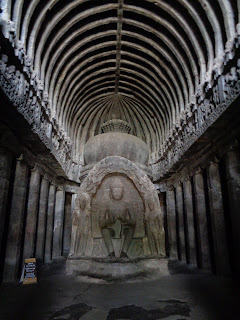Durgapur, Kolkata, and Shillong
On 5/31, we moved to Durgapur, an industrial city northwest
of Kolkata. Along the way, we stopped at Burdwan University, home of Professor
Mujumder, guest professor and childhood friend of Professor Ganguly. At the
university, Rose and I were part of a panel discussion with a few graduate
students from Burdwan University. I spoke about the ethical dilemma faced when
industrializing and providing electrical power to the 400 million people in
India who do not have power. Access to electricity greatly impacts quality of
life; should India provide power to its citizens as quickly as possible using
coal power, or should it develop a sustainable network of renewable energy
sources? Developing renewable sources will be more expensive and slower—if this
option is chosen, it is the rural citizens without power who pay the price.
This debate also applies to how India should industrialize: how much
responsibility does India have to industrialize in a green manner and thus
atone for the emissions of the industrialization of developed countries? The
other panelists talked about environmental awareness, groundwater policies,
environmental management systems, and the Paris climate talks.
We continued on the long bus journey to Durgapur, making a
few stops before our hotel. Professor Ganguly grew up in a village near
Durgapur; we stopped at his elementary school, St. Xavier’s. We then picked up
another school friend of his named Apunam. It seems that everyone we meet in
India is a school friend of Professor Ganguly—the chef, multiple professors,
extra guides for some cities we visit. When we finally made it to Durgapur, it
was dark out. We stopped at a dam where Apunam sang for us, then visited his
home to see what a standard Indian home looks like. His house reminded me a lot
of the Cuban house I stayed in for one night last summer. It was cozy and warm
(AC only in the master bedroom). Apunam’s wife served us a green mango juice
drink, similar to one that I had in Mumbai when I went to a Bengali restaurant
with Professor Ganguly. It was great to see an Indian home and get a sense of
how many people grow up in this country. One can learn much more from visiting
a home than from days of staying in hotels.
On 6/1, we drove northwest from Durgapur to Asansol to visit
the Maithon dam. Before entering the dam, we took a speed boat ride to an
island in the dam reservoir. The small island had a playground and lots of
strange public features, including benches whose legs were statues of two small
people holding up the seat and a trash can that looked like a headless elephant
sitting on a tricycle. While hanging out on the island, we saw some fisherman
down below in the reservoir placing and collecting a large net. The speedboat
ride was short—only 10 minutes—but very enjoyable. The boats were about 12 feet
long with a few seats and lots of opportunity to be splashed to cool down.
After the boat ride we had a snack of some masala chips and some fried lentils
with spicy green mango chutney.
We then got a tour of the dam. The dam has three 20MW
generators powered by Francis turbines, a special type of underwater turbine
that utilizes pressure rather than the energy of falling water when the water
level is low in the reservoir, as it is now during the dry season. I walked
around with Udit and another mechanical engineering student and learned a lot
about the dam from an engineer there. After the visit to the dam, we drove back
to Kolkata through lots of traffic and got ready for our early flight the next
morning.
On 6/2, we traveled to Shillong, a mountain city east of
Bangladesh, via a flight to Guwahati and a drive up the mountain. Knowing that
Shillong is relatively cool (temperatures around 70 degrees F), I wore my jeans
during the travel day. Guwahati, it turns out, is not cool; it was over 90F
when we landed. Our lunch stop in Guwahati was mediocre overall, but the
tandoori chicken was fantastic. I am looking forward to having more of this
when we go to Delhi later this week. Instead of a large bus, we took a group of
small cars up the mountain to Shillong. The landscape was much different than
other areas of India I have visited—green, foggy, and mountainous. The physical
features of the people here are a mix of Tibetan and Indian. The food also has
more East Asian qualities.
Along the way we stopped at an overlook and had some
delicious small plums as snacks. I have disregarded the “don’t eat any fruit
with skin” rule, as has most of the group. I also had some tea from a stall at
the overlook. A large amount of sugar is added to almost any cup of tea on the
street in India, so it tastes great. Tea on the street is often served in very
thin plastic cups that do not look like they are made to hold boiling water. This
might not be the safest thing to drink every day for a long period of time, but
it is too good to pass up while I am here in India.
Pictures coming soon, I promise.



Comments
Post a Comment